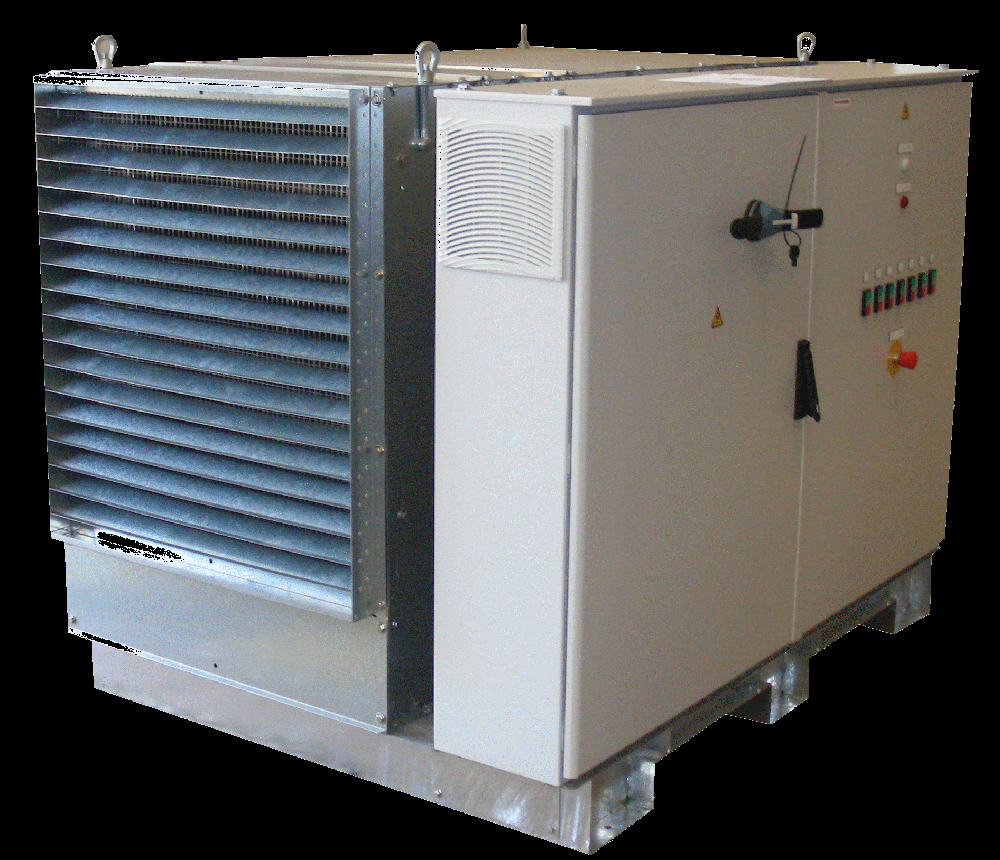The equipment
The Load Banks are devices designed for the supply of electric charges in order to prove the supply of electric power. They simulate variable conditions of electrical charge that can be controlled, measured and recorded accurately.
The objective of these devices is to test the power protection system (and components) under load conditions but without risk of supply to protected loads.
The equipment has a metallic armor, and is composed of large resistances with a heat dissipation system (cooling). It has fans that are responsible for evacuate the heat generated and a fairly complete electronics that allows load regulation in minimum jumps of up to 1kW. A software processes all the information collected during the test to subsequently report the generator's operation throughout the process.
It has a practically zero direct amortization, but it improves the quality of the service a lot.
Applications
• Test of electric generators groups (in factory).
• Tests of UPS systems.
• Battery system tests.
• To reduce sublimation problems of diesel engines.
• Periodic tests of back-up or emergency generator groups.
• Tests of "land" systems.
• Generator Turbine tests.
Amperis offers Load Banks for different applications and of different capacities, resistive or reactive.
The load banks can be portable, permanent installation or mounted on trailer for outdoor, mounted on radiator.
From the previous applications, the most outstanding applications are:
- Manufacturing test: The load banks, associated with a generator set, allow the group to be loaded in order to avoid incrustations in diesel engines and to wear out prematurely, particularly with low power.
- Generator test: Generators and other motors that generate electricity for emergency systems (hospitals, data centers, ...) must be tested every month. These tests are carried out by means of load banks that allow to determine their capacity of operation and their reactivity to start up.
- Maintenance of the batteries of the accumulators: The charge bank allows the battery to be discharged to avoid premature wear. They are used especially in electricity laboratories, on test platforms, in data centers and in telecommunications.
- Test bench: The load banks are used to test and adjust the protection and cutting devices.
- To reduce problems of sublimation of diesel engines: One of the most prominent uses of load banks is to eliminate or reduce the accumulation of carbon inside the cylinders of diesel engines in generator groups of emergency or backup, because of the low or no load with which they operate most of their useful life (an extreme case are the emergency generators, which are usually started periodically to check their operation but without connecting any consumption).
The main causes of a diesel engine failure is "carbonization" (accumulation of unburned fuel in the pistons of the engine) and this occurs when the generator operates with a low load. Additional negative effects to the carbon accumulation include smoking leaks, problems in the fuel system and deterioration of the lubricating oil, etc. all of which decreases reliability and increases operating costs.
Diesel engines with very low load or that operate in vacuum for long periods, never reach the recommended operating temperature. Over time, the unburned fuel, charcoal, covers the combustion chamber, reducing the nominal capacity, the efficiency and the service life of the engine. Therefore, it must be subjected to a periodic effort, because these residues cause the performance of the engine to decrease or even cause breakdowns. When applying load bordering the power limit of the generator set, we get all of these remains to burn and keep the engine in optimum conditions to ensure operation in a real environment.
A program of preventive maintenance that includes tests with load of the generating plant will reduce the harmful effects of the "carbonization" and will increase the useful life of the engine.
Markets
• Oil and Gas
• Transmission and distribution
• Industry
• Energy
• Nuclear
• Data center
• Renewable energy
Importance
Both the commercial and manufacturing industries emphasize that a preventive maintenance program is vital for an emergency or reserve generator to operate reliably. Load Banks become an essential part of such programs by providing practical means to test the power systems without the need to interrupt critical loads. Proper testing of the backup power generation system of a facility is a way to identify weaknesses in the system.
Load Banks convert electrical energy into heat. Much of this heat is dissipated thanks to a cooling fan. However, the cabinet tends to absorb a portion of this heat, so it must be built with a material that supports these thermal environments.
What is the load bank test?
The test starts by starting the generator slowly, making it work from 25% to 100% of its capacity, thus being any apparent problem. In most applications, UPSs are important because they provide power to the loads so they can operate during a power outage. For this reason, load bank tests are carried out to ensure that UPS complies with the expected operating requirements when it is most needed. For this reason, the load bank test is the most effective form of preventive maintenance to validate the correct operation and autonomy of the UPS system battery by testing the UPS and the generator under load conditions.
Load bank tests are also used to determine the condition and condition of UPS batteries and battery packs. With the load bank we check if there are individual cells near the end of their useful life and thus avoid future failures allowing them to be replaced before the critical application. This is important since the set of batteries in a UPS is as strong as its weakest cell.
To test complete UPS systems, an AC load bank is used, while a DC load bank is used to test batteries. Reactive load banks are also available (usually with a 0.8 lagging power factor) but tend to be larger and heavier in design.
Test results
The load bank test will ensure that the components within the energy protection system function correctly and do so together when requested to support a critical load.
With the measurements taken during the discharge it is possible to determine the performance of the battery and the system. A load bank test identifies problems with the generator and UPS and indicates corrective actions that must be taken. In the case of a backup generator, a load bank test gives us a lot of generator information such as: the motor's ability to provide the required power, stable frequency, efficiency of the control systems under variable load conditions, system and the oil and fuel pressure. It will also help eliminate piston deposits, smelters and engine leaks, identify potential weaknesses and record the results and any work that needs to be done.
During the test, heat dissipation and noise attenuation must be taken into account.
Benefits
• Ensure that the generators operate at 100% capacity.
• Reduce the risk of generator failure during an emergency.
• Reduce the chances of mechanical failure.
• Increases the life cycle of the engine and its efficiency.
• Clean the generator.
Types

15kW – 400 V

600kW

Tunel type